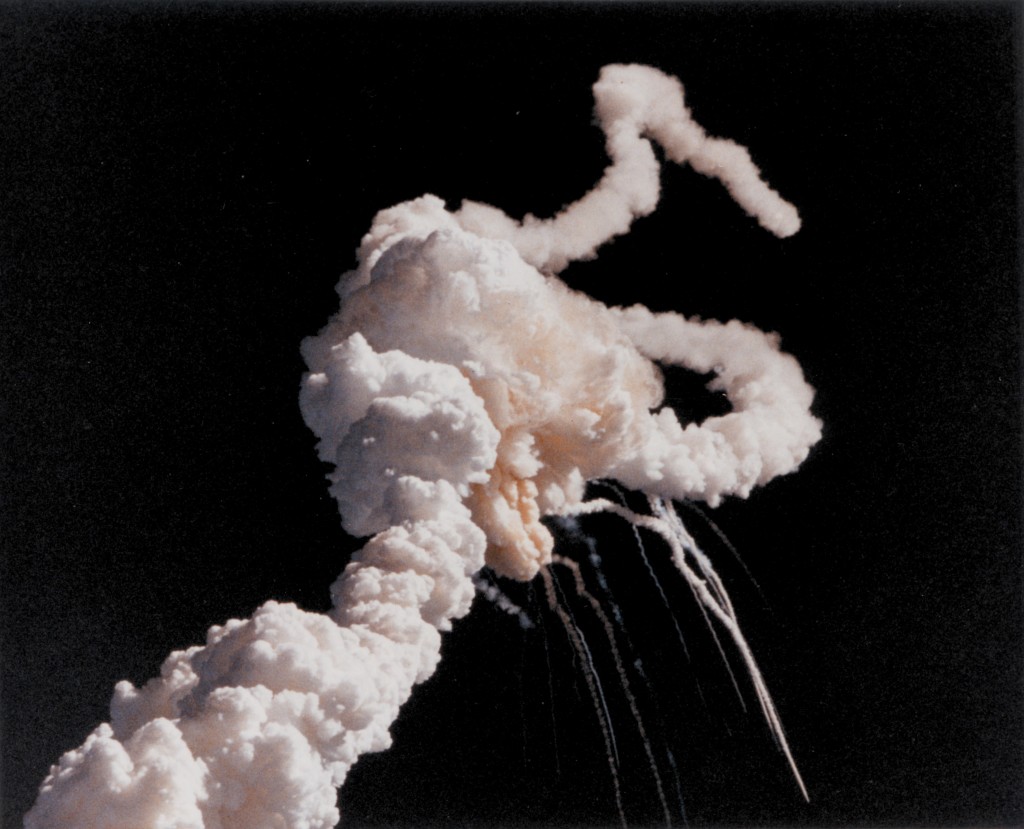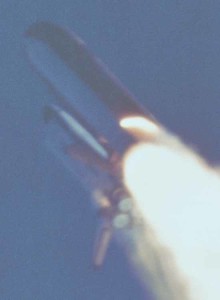Today marks 32 years since the Challenger Disaster. On January 28th, 1986, The Space Shuttle Challenger was destroyed 73 seconds into it’s 10th mission due to one of its solid rocket boosters having a failed o-ring in a joint between 2 sections of the tubing, causing a burn thorough which over a minute of flight burned it’s way through the massive orange external fuel tank of the vehicle, resulting in it’s breakup over the Atlantic ocean.
The event is known most properly as the Challenger Disaster, but many refer to it as the Challenger Explosion.
This name is incorrect. The Space Shuttle Challenger did not explode.
Yes, it broke apart during launch, but it wasn’t an explosion.
Now, I know what many who read this are thinking: “You can look at the video, it clearly blew up. It exploded, look at the puff of flame when it happens!” or something similar.
Let’s step back a bit, and look at the actual event. We will take a common image from the Challenger Disaster, and study it, while discussing just what actually happened 73 seconds into it’s flight.

Alright, let’s look at this image, one of the more famous ones of the event, and one that’s highly detailed. You see plenty of “white smoke” a bit of orange, and to the bottom right, the remains of the Space Shuttle Main Engines and some smaller rocket systems on the Orbiter descending towards the ocean.
The lower left is, of course, the plume from the Solid Rocket Boosters – you can see them continue wildly after the vehicle broke up, both in this image and in the video footage of the event.
In the middle, though, you see the cloud from the breakup, the area where the “explosion” happened.
The thing is, where is the fireball? Where is the actual flame that is part of an explosion (in this context) by its very nature? It’s nowhere.
What you see in the middle, the white cloud that formed as the vehicle broke up, is the un-burned liquid oxygen and liquid hydrogen fuel stored in the External Tank of the Space Shuttle, having been released from the tank as the vehicle broke apart.
There was some burning of a small bit of the the mixed vapors, of course, but amazingly no actual fireball was formed. The remains of Challenger that were recovered show minimal, if on most cases any, burn damage.
As for the orange you see? Those are the hypergolic fuels for the Reaction Control System and the Orbital Maneuvering System. Traditionally, the main oxidizer used in these types of systems is dinitrogen tetroxide which has a distinctive reddish color to it. It can be seen in all Titan missile launches, for example (especially those of the Gemini missions) and of course here, as the vehicle broke up, the OMS and RCS fuel systems spilled their contents, resulting in the orange cloud appearing in the same area that the Challenger orbiter was in when it broke up – on the “bottom” of the Shuttle stack.

So what happened to Challenger, exactly? In the above picture, you can see the flame coming out of the right Solid Rocket Booster. Basically, this flame coming out of the failed joint was in such a position that it not only began to burn into the fuel tank, it also burned the mounting point for the booster and eventually, the booster broke free of its attachement point, moved out a short ways then slammed into the already weakened and slightly leaking lower part of the External Tank, which held the liquid hydrogen fuel. The Hydrogen tank itself at this same time was failing, and actually began to move upwards into the oxygen tank.

With the external tank failing, the entire orbiter stack broke apart – Challenger itself being shredded by aerodynamic forces, rather than the force of the breakup or the non-existant “explosion”. The parts of the orbiter followed a perfectly standard trajectory for such a breakup, and large segments of the vehicle could be seen leaving the cloud to eventually crash into the Atlantic ocean.
Challenger didn’t explode. It disintegrated due to structural failure of the external tank caused by a burn-through of the right hand Solid Rocket Booster. Sadly, many sources, even some with NASA, state the event was an “explosion” but that’s not true – not technically, and not in the practice of understanding what actually did happen to the vehicle.
In 2017 I shared in an article on the Disaster this video on the disaster which details exactly what happened during it in very stoic detail. This point, timestamped, explains that there was no explosion. While the whole video is worth checking out, I’ll leave this bit timestamped here for you to listen to:
This all being said, it doesn’t change the fact that the event happened. I strive for accuracy in what I know and understand about the world, the good or the bad events, and I don’t like when the Challenger Disaster is called an explosion because that’s simply not true and creates an improper presumption on what actually happened during the event.
For more details, as I’ve shared before, you can read these wiki links and follow sources cited in those links for even more details.
https://en.wikipedia.org/wiki/STS-51-L_Mission_timeline
https://en.wikipedia.org/wiki/Space_Shuttle_Challenger_disaster (it should be noted that while this article quite repeatedly states there was an explosion, this comes from it being written in a common style – there is a section that states “Challenger veered from its correct attitude with respect to the local airflow, resulting in a load factor of up to 20 (or 20 g), well over its design limit of 5 g and was quickly ripped apart by abnormal aerodynamic forces (contrary to popular belief, the orbiter did not explode as the force of the external tank breakup was well within its structural limits)” in the section on Vehicle Breakup.
https://en.wikipedia.org/wiki/STS-51-L_Mission_timeline
[Edited to fix error of repeatedly referring to the right booster as the left[
